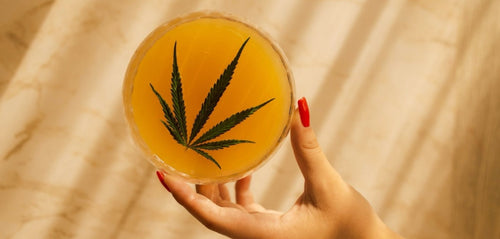#10: Learn How to Make Cannabutter at Home
#10: Learn How to Make Cannabutter at Home
Long before edibles were available for purchase in dispensaries, cannabis-infused butter (or ‘cannabutter’) was a popular way to make food with cannabis. Cannabutter is a simple ingredient that can unlock endless possibilities in the kitchen, allowing you to infuse your recipes with cannabinoids for enhanced flavour, therapeutic value, and recreational purposes. Its potential as a versatile ingredient has made it a staple in cannabis cuisine. And it's easier to make than you might think! Let's take a look at how to make cannabutter at home.
Step 1: Decarboxylation

The first step in making cannabutter is decarboxylation, which is the process that activates the cannabinoids found in cannabis (THC, CBD, etc.) so that they can interact with the body. When cannabis is heated to a certain temperature, it will release carboxylic acids and other compounds, allowing for the activation of THC into a psychoactive form or CBD into a non-psychoactive form. The end result is a product that is more potent and offers enhanced therapeutic value.
To decarboxylate cannabis, grind your cannabis buds or trim into a coarse texture and spread them evenly on a baking sheet. Place the baking sheet in an oven preheated to 240-250°F (115-120°C) and bake for 40-50 minutes, stirring the cannabis every 10-15 minutes. This will ensure that all the cannabinoids are properly activated. Decarboxylated cannabis will be a light brown colour and should have an earthy, nutty smell.
Step 2: Infusion
Now that your cannabis is decarboxylated, it’s time to infuse it with butter. The ratio of decarboxylated cannabis to butter will depend on the desired potency of your cannabutter, but a good rule of thumb is to use 7 grams of cannabis per 1 cup of butter.

What you will need:
- Decarboxylated flower or trim (about 7-10 grams)
- 1 cup unsalted butter (2 sticks)
- 1 cup of water
- Cheesecloth
- Pot or double boiler
Melt your butter in a pot or double boiler on the stove over low heat. Add a cup of water to the mixture to help prevent scorching. Once the butter is melted, add your decarboxylated flower or trim and stir well. Reduce the heat to low-medium and let the mixture simmer for 2-3 hours, stirring occasionally.
Once the cannabutter infusion is complete, it’s time to strain out any plant matter that may remain in the mixture. Cool the mixture to room temperature and then place a cheesecloth-lined strainer over a bowl or jar and pour your mixture through it. Using a spatula, press down on the cannabis to ensure that all the butter is squeezed through. Discard the strained plant material and store your cannabutter in an airtight container in the refrigerator until ready to use.
Dosing and cooking tips
When cooking with cannabutter, it’s important to remember that the effects of the cannabis will be more potent than if you were just smoking or vaping. Because THC is fat-soluble, it binds to the butter, creating a more powerful product. A 50mg edible can be overwhelming, so it’s best to start with small doses and work your way up. If a recipe calls for 1 cup of butter, you may want to use less than that.
Another tip is to pay attention to the temperature your cannabutter is cooking at. Too much heat can degrade the THC and other cannabinoids. For this reason, it’s best to keep your temperature low and slow. Lastly, it's a good idea to add extra fat like cream or oil to a dish that contains cannabutter. This will help spread the THC throughout the dish and ensure even distribution.
Dishes you can make with cannabutter

Once you have made your cannabutter, there are plenty of delicious dishes to make with it! Here are some of our favorites:
- Cannabis-infused brownies. These decadent treats will be sure to satisfy any sweet tooth.
- Cannabutter popcorn. Who doesn’t love a classic movie night snack?
- Cannabis-infused mac and cheese. This is a classic comfort food made even better with cannabutter!
- Cannabis-infused cookies. These are great for afternoon tea or snacking on the go.
No matter what your recipe of choice is, cannabis butter can be a great way to add an extra punch of flavour and fun to any dish. So get cooking!
The best strains of cannabis for making cannabutter

Choosing the right strain of cannabis for making cannabutter is important, as different strains contain different cannabinoid profiles that can affect the potency and effects of your edibles.
Indica-dominant strains are known for their relaxing and sedative effects, making them good for nighttime use. Some potent Indica choices are Farm Gas, First Class Funk, and Pure Cake Skunk.
Sativa strains, on the other hand, are more energizing and can help with focus and creativity. Highly potent sativa strains for cannabutter include Crescendo, El Gordo or Tyco Haze.
Finally, hybrid strains give users the best of both worlds, providing the alertness of Sativa with the relaxation of Indica. Popular hybrids include Animal Mints, Frequent Flyer, and Mandarin Cookies.
No matter which strain you choose, it’s important to know the THC content before making your cannabutter. Use an edibles calculator to help you determine the correct dose for your needs. That way you can adjust the amount of cannabis used in your recipe accordingly.
Ready to get cooking?
Now that you know all about cannabutter, its benefits, and how to make it yourself, it’s time to put that knowledge to use. Whether you’re looking for a treat to share with friends or a special snack just for yourself, cannabutter is perfect for enhancing your dishes. With a bit of practice, you’ll be able to find the perfect strain, dose, and recipes to create the perfect cannabutter-infused treat. So get cooking, and happy infusing!
Would you like to chat and learn more about how to make cannabutter? Come connect with us on Discord. Our moderator, 416Smokebar, is a former chef who loves cooking with cannabis and would be more than happy to answer any questions you may have!











